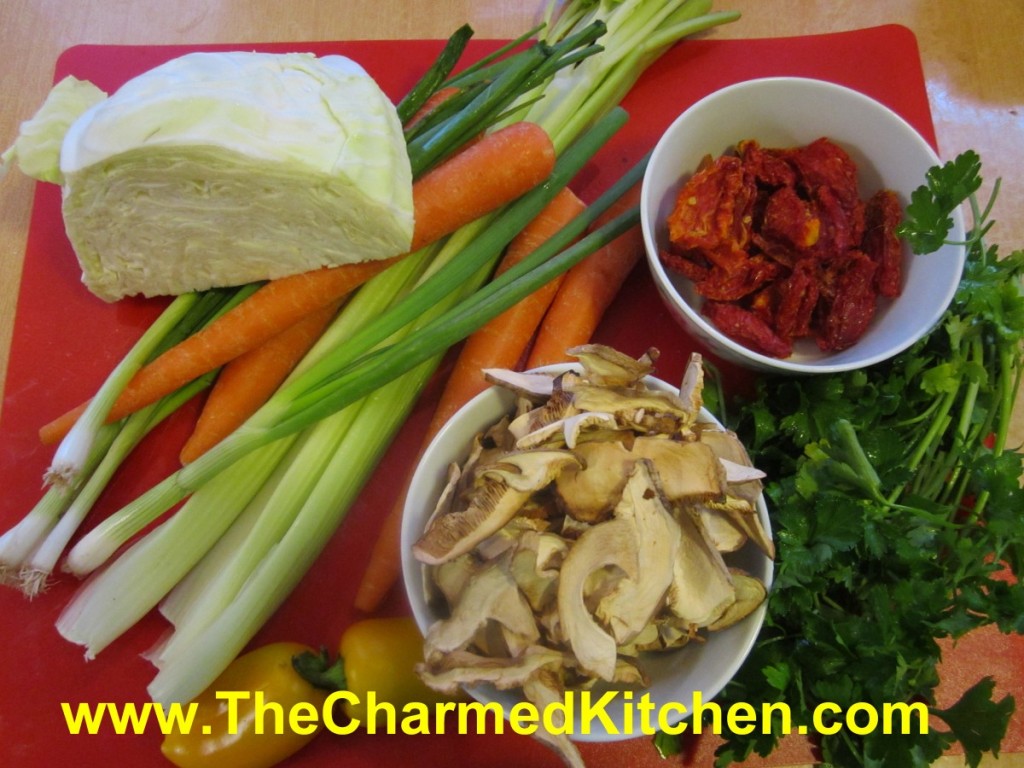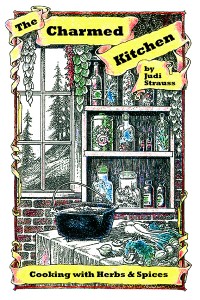Pantry Cooking – Soups

I want to do something to help people get though this. I thought about posting a recipe using my pantry items, but it occurred to me that unless you had the same stuff as what is in my pantry, it might not be that helpful. So I came up with a different idea. More general information to help you get the most out of what you have on hand.
The 3 S’s
When it comes to meal planning remember the three S’s- Soups, Stir Fries and Salads. All of these are dishes that give you room to get creative, use what is on hand, and use up almost any type of leftovers. We’ll start with Soups today.
Soups
By definition, you’ll need some sort of liquid to make broth for the base of the soup. I won’t assume you have piles of bones hanging around to make a stock. So what might you have? Roasting a chicken? Cut meat off the bones to serve, and save the carcass. People do that all the time with turkeys at Thanksgiving. Those bones will make a great soup. Same with bones from steak, roasts, anything really, even spare ribs. Ham bones are a classic to make stock.
No bones? Do you still have a corned beef to be cooked? The water the corned beef is cooked in can be used as a base for soup. If it it too salty, just dilute it with water. Other non- bone sources for stock might include tomato juice or the cooking water from vegetables.
Think about that last one. You might cook veggies by either boiling or steaming them. Before you toss the cooking liquid- that water has picked up flavor from the veggies. Save it to use for later. You can use it again, to cook more veggies, to give your water even more flavor. Now you can add your veggie water when making soup stock for more flavor.
Pan drippings are a great source of flavor for soups. When you finish cooking a roast, you will have those lovely brown bits in the bottom of the pan. They actually have a name. They are called the fond. Add water to the pan and heat up over a medium low flame. Scrape as much as you can off the bottom of the pan. You can de-glaze with wine or sherry, if you prefer. Pour through a strainer into a heat proof container and let cool down. You can remove the fat from the top later. Store in the fridge for a few days or freeze to use later. The drippings don’t have to just be from meat sources. If you roast veggies, you will have similar brown bits. Get those flavors out of the pan the same way.
Try to use as many of the aromatics as you can get your hands on. They will help to give you a richer stock for your soup. Aromatics would include onions, carrots, celery, garlic, sweet peppers and herbs. If you don’t have a lot of extra veggies to make your stock, use the parts you might normally toss. It’s going to be strained out anyway, so use everything that gives flavor. Use the carrot peels, celery tops, onion and garlic skins, herb stems, cabbage cores, you get the idea. If you are peeling onions or carrots or potatoes and can’t use the peels right away, start a “soup bag” for the freezer.
To actually make your stock, place all the ingredients in a pot and add water, if needed. Simmer together for at least a few hours. Crock pots can be a great place to let stocks cook away. If you are lucky enough to have raw bones, you can roast them first, before adding to the stock pot, or brown them right in the stock pot. I am assuming you don’t have access to lots of bones, so I am working on the idea of making soup stock without them.
Once you cooked all the flavor out of your ingredients, strain your stock and add salt and pepper to taste. Now you can use it to make any number of soups. If you want more “stock” you can add other liquids to your soup like tomato juice, milk, coconut milk, rice milk, oat milk…. you get the idea.
You’ll want some protein for your soup. Diced up meats are traditional, but you can use, sausage, mini meatballs, cooked bacon (save the grease), tofu, eggs (egg drop soup) , dry peas or beans, lentils, nut and nut butters. You want to think outside the box.
Add veggies you have around. This is great time to check out what is in the fridge, freezer and pantry. Soups are a great place to use up that bit of leftover green beans from dinner last night or the can of corn whose expiration date is coming up.
I like my veggies to still have some texture to them, even in soup. Some vegetable that hold up well are carrots, onions, cabbage, turnips, parsnips, beets. You might see a pattern. For the most part, root vegetables hold their shape and texture even in long cooking. Vegetables that require less cooking can be added later. Greens like spinach and escarole or kale, and veggies like broccoli, cauliflower and sweet potatoes all cook pretty quickly. Add later to keep them from falling apart.
I feel like tomatoes deserve special mention. Canned tomatoes, in so many forms, can really make your soup better. From juice, diced, whole, sauce and even tomato paste. In different amounts, tomato products can add a lot of flavor to most any soup. Same for fresh tomatoes. If you feel like your soup is in need of a punch, consider adding tomato in some form.
Don’t be afraid to add seasonings in the form of herbs and spices. Hot sauce is always a fun addition. Sometimes, you can add a little zip by adding less common ingredients- perhaps a splash of vinegar or some lemon juice. You might be surprised at how a little acid can brighten up your soup. Taste as you go, and adjust until your soup is just what you want it to be.
When it come time to add carbs like pasta, rice, barley it really will depend on what you have and what you like. With the exception of minestrone or Italian Wedding soup, I keep my noodles out of my soup, until ready to serve. I find for classic chicken noodle soup, the noodles get mushy if added to the whole pot of soup. Cook your noodles according to package directions, then let everyone add noodles to their own bowls and ladle in the hot soup. For rice that is being cooked in the soup, add less than you think. The rice is going to cook and swell and absorb liquid. You still want soup in the end, not a rice casserole. A rounded half cup of raw rice for every two quarts of soup should be about right. Same for barley. You can make spaetzle, if you don’t have other pasta around. Here is my recipe.
Spaetzle
3 eggs
1/2 c. half and half or evaporated milk
1/2 t. salt
1 1/2 c. flour
Combine all ingredients and let rest 30 minutes. Drop by small spoonfuls into boiling water. Cook until they float and puff up, about 5 minutes. I use a spaetzle maker, which produces smaller pieces. I only cook them a couple of minutes. Drain and serve with soups, stews, sauces or buttered. For the paprikash, I browned the spaetzle, after cooking, in a butter- oil mixture. I also tossed in some fresh parsley at the end.
Another option is to make a pureed soup. Toss all your veggies into a pot, let them cook until very tender, and then puree until smooth. I often make pureed soups using a ham bone or smoked turkey to flavor the soup. Once the soup is cooked, I remove the bone/meat, and puree the soup. Then I remove and cut up any meat from the bones, adding them to the soup.
Think about the color of your ingredients before you make a pureed soup. Once pureed, the colors mix. I try to pick a dominant color for a pureed soup. Over the years, I tend to make orange, green or pink soup. Orange soup would have carrots, winter squash and/or sweet potatoes as the main vegetables. Green soup relies on spinach, broccoli and green beans for it’s color. Pink soup is made with beets, but I think you already figured that out. Even if your soup color turns out kind of brown, it should taste good, but I like it to look good, too.
After all the talk about making a soup stock from scratch, you can make your own vegetable soup base. It keeps for ages and ages. You just add a spoonful or two to water to make vegetable broth.
You might not be able to find all of the ingredients, but even if you get most of them, you should be able to make a really good veggie stock.
I make a vegetable soup base that is a mixture of vegetables, both fresh and dried, herbs, mushrooms, nutritional yeast, spices and salt. There is pretty good amount of salt, but I wanted to be able to store it in the fridge and be safe.
It worked out that every teaspoonful of the finished base has less than 1/4 teaspoon of salt. Not great, but a lot less than bouillon cubes.
If you want to make yours with less salt or no salt- you’ll have to freeze the mixture in ice cube trays and take it out of the freezer as needed. Sort of like your own bouillon cubes.
The nice part is, I can now make a vegetable soup easily and I know exactly what is in it. It can also be added to chicken or other meat-based stocks, in place of the salt, to add extra flavor.
Homemade Vegetable Soup Base
4 carrots, peeled and cubed
3 celery ribs, washed and cubed
1 large sweet onion, peeled and cubed
3 green onions, washed and cut up
1 c. sun- dried tomatoes, soaked in water 30 minutes, and drained
1 c. dried mushrooms, soaked in water 10 minutes and drained
1 c. chopped cabbage
1 c. parsley, chopped
1/2 c. chopped sweet pepper
1/4 c. nutritional yeast, optional
2 T. turmeric
8 oz. salt- I used sea salt and used a scale to weigh it. It’s around a cup but will differ if you are using a coarse salt
Combine all ingredients, except the salt, in a food processor and blend until smooth. I have a decent size Cuisinart and still had to do this in batches. Combine in a bowl with the salt and stir well to blend. Store in a clean jar in the fridge until ready to use. I ended up with about 5 cups of soup base. To use, add about 1 teaspoonful to a cup of hot water for vegetable broth. Use less or more according to your taste. Use in place of salt in other soups, stews and sauces.
I hope this has been helpful. Don’t be afraid to just use what you have around when it comes to soup. Taste as you go, you can always add more, but it is hard to take out what you’ve added too much of. Check though your pantry, fridge and freezer for ingredients that might be a nice addition to your soup. Be creative and try to have fun. We could all use a little fun right now.
Stay strong- we will get through this.




